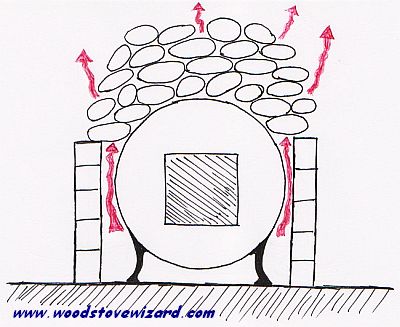Modifying Barrel Stove Kits
Barrel stove kits can be improved upon with some fairly simple adaptations. First consider some of the features of these stoves that are distinct from other types of wood stove.
Go back to the main barrel stove page...
- Thin wall construction means the external surfaces get extremely hot - too hot for confined spaces - and are a possible fire hazard to flammable objects within many feet.
- They can heat a space very rapidly when lit - fast response time
- Barrel stove kits have a reputation for burning with a smoky flame which may be undesirable
- They can take a massive fuel charge - you can keep the fire in for longer but this also encourages damping down and smothering the fire (this is inefficient of fuel and very polluting)
- Low mass means they stop heating your space as soon as the fire goes out
You might like to consider adapting your barrel stove kits to alter some of these characteristics.
Make it a thermal mass stove
Thermal mass is relatively easy to add to your homemade wood stove - all you really need is a big pile of rocks, concrete or sand to absorb the heat from your hot burn and release it over a few hours afterwards Thermal mass will keep the chill off the night air once your stove has gone out for the evening.
A great big pile of rocks....
This option should be very effective. Build a frame around your stove out of concrete blocks and pile heavy stones above and around the stove. The concrete framework helps stabilise the barrel stove and support the rocks above. because the rocks are loosely stacked air circulates between the stones so the entire thermal mass gets warmed by the fire.
Choose your stones carefully - some are known to shatter due to moisture in them. Flint is particularly bad, granite should be safe.
A tonne or more of stone and concrete is ideal - the more mass you have the hotter your initial fire can be, and the longer it will warm the space for. Remember you may need to consider strengthening the floor to support the additional weight.
Stones stacked on and around your wood stove actually improve safety - the stones will get hot but are unlikely to burn if you brush against them. They also reduce the chances of something accidentally igniting through contact with the stove.
Thermal mass stoves typically work by having one initial hot fire and then the stone work gently releases the heat into the room over many hours.
An internal layer of sand...
|
This option is a little trickier to manage but has some neat advantages. Effectively you are trying to build a smaller barrel stove within the 55gal drum, and part filling the intervening space with coarse sand. The overall thermal mass will be less than piled stones around the stove, however you can use the sand to direct the heat from your stove. Barrel stoves usually radiate their heat indiscriminately in all directions and nearby surfaces such as floors and walls can become dangerously hot, even with large clearances from the stove. This double skin design reduces the size of the firebox (a bonus in most cases as a 55gal drum is a huge firebox), and directs heat to the top of the stove rather than the bottom or sides. I haven't yet seen a design which incorporates it, but it should be possible to use the upper space between the two barrels as a secondary burn chamber by adding a secondary air source and offsetting the flue vent holes. At a more basic level you could put a few inches of sand in the bottom of the stove and rest your firewood on it. |
Add an internal grate
One common addition to these stoves is a simple grate. These are not essential (most conventional wood stoves don't use a grate, the firewood sits on a bed of ashes) but can help to get an efficient burn by improving air circulation.
A grate also protects the bottom of the barrel from the hottest part of the fire and reduces the chances of the barrel burning through or otherwise failing. A layer of sand will also help with this.
These can be bought directly from amazon to fit the vogelzang barrel stove

